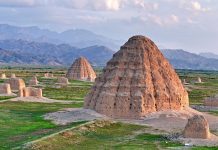BEIJING: Residents of deeply impoverished localities generally live lives full of toil and hardship as a result of factors such as limited infrastructure, rocky terrain and inconvenient transportation.
I recently traveled deep into Zhaojue county, Liangshan Yi autonomous prefecture, Sichuan province via a rocky, winding road that runs through the Daliangshan mountains. The ethnic Yi citizens that live in Liangshan constitute the largest Yi community in the country and account for more than half ofthe prefecture’s total population of 5.21 million people.
Most peopleonly see pictures and videos of Sichuan’s rugged,desolate mountain landscapes in the media and never experience them in person. In 2016, a newspaper published photos of 15 children climbing a patchwork of rattan ladders mounted to the side of an 800-m-high cliff in Zhaojue’s Atuleer village in order to get to school, and the story attracted widespread attention. The public was shocked by the dangerous route that the students had to take every day and began referring to the hamlet as China’s “cliff village.”
I was touched by the Yi people living in Atuleer when I became aware of their situation and began thinking about their lives and the unique landscape in the region.
The village has since become much more prosperous and can be seen as a microcosm of China’s poverty alleviation efforts in destitute areas.
Atuleer native Mouse Wuha’s social media followers often refer to him as “Aixiaoshu” (“uncle who likes to smile”). The optimistic 48-year-old is a member of what was one of the last impoverished families to relocate from the village to new homes in a resettlement community. He began running a shop near his residence and currently earns about2,000 yuan (US$289) per month.
“We help impoverished rural citizens renovate their dilapidated homes and people who live in inhospitable regions relocate to more prosperous areas as part of the national government’s poverty eradication campaign,” stated Pacha Youge, first Party secretary of Atuleer. “Our efforts have helped 84 of the village’s families escape from poverty thus far.”
Pacha climbed the dangerous ladder system that used to exist in Atuleer more than 400 times over the course of about five years. He discovered a long, narrow fissure running through some of the cliffs in the village in 2014, so the government decided to help the households that lived near it and in other unwelcoming areas relocate.
Atuleer native Jike Guzhe sold his cattle before he moved into his new home near the central county area and began working on adapting to his new life. It was not easy for the father of four to say goodbye to his traditional lifestyle and the residence that he had lived in for decades, however. He ultimately felt determined to move to the resettlement site with his wife and kids after feeling disillusioned with the harsh conditions that they had been living in, such as a lack of running water and electricity and cohabitation with livestock.
“It was like a dream,” Jike recalled. “I have never seen the type of homes that are at the resettlement community in person before I left my village, and now my family lives in one.
– The Daily Mail-Beijing Review News exchange item





